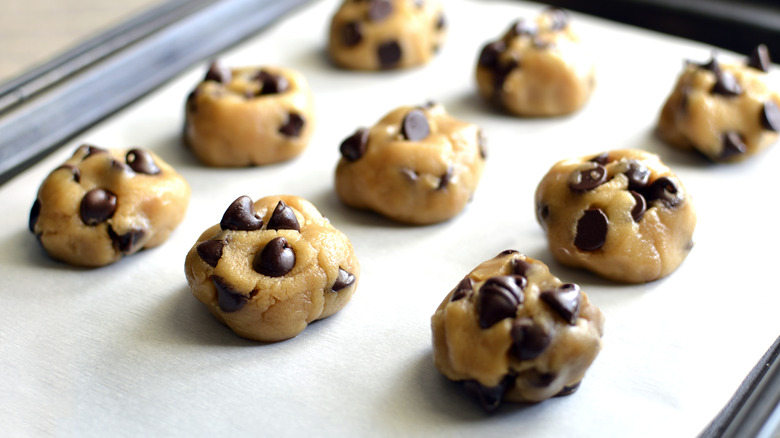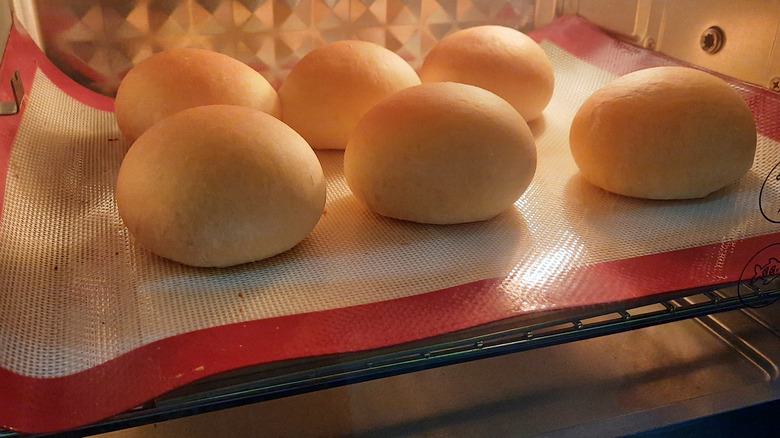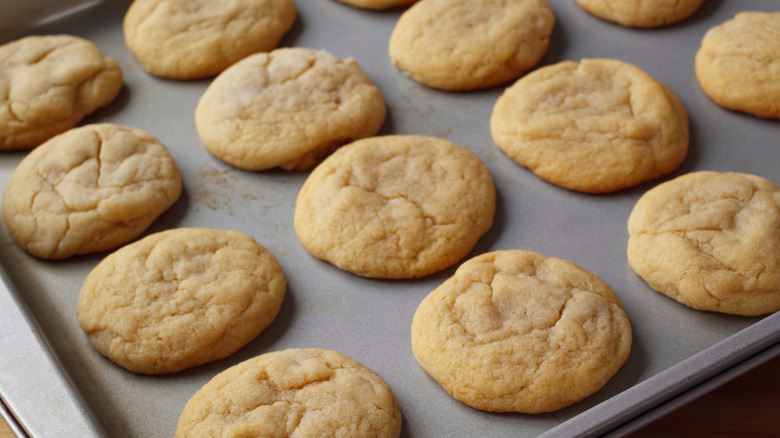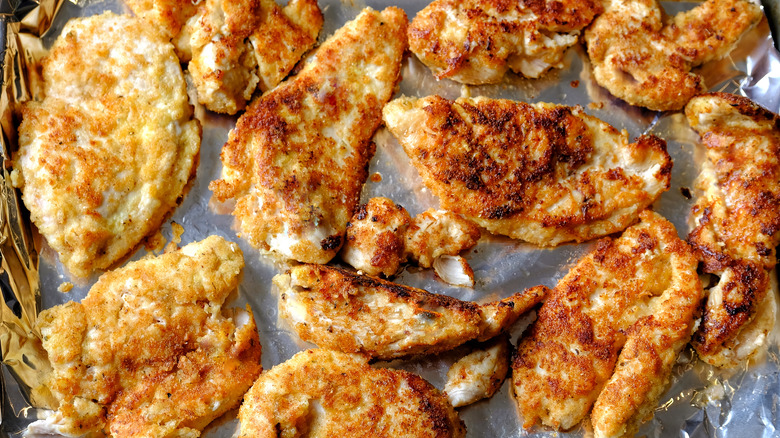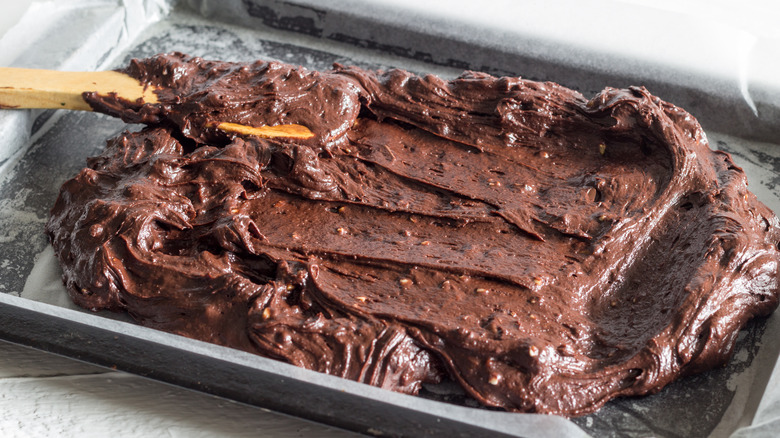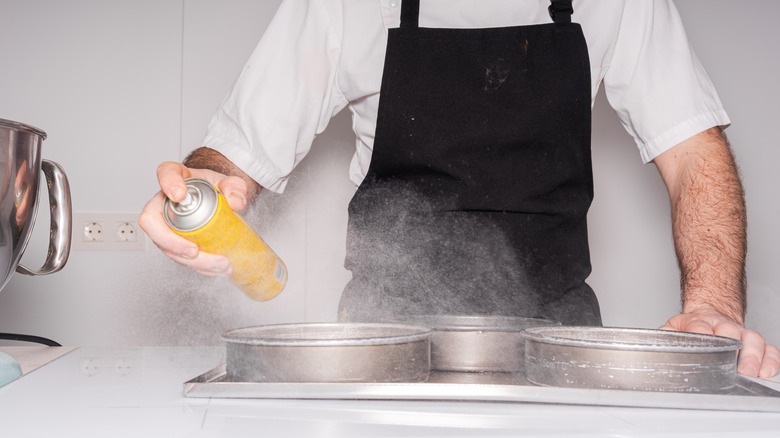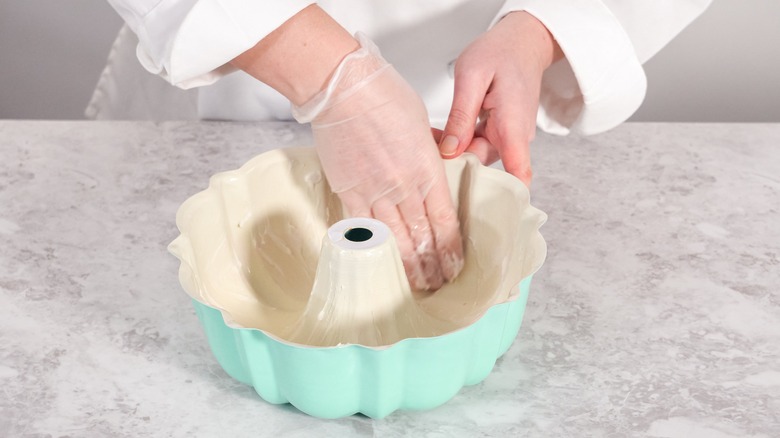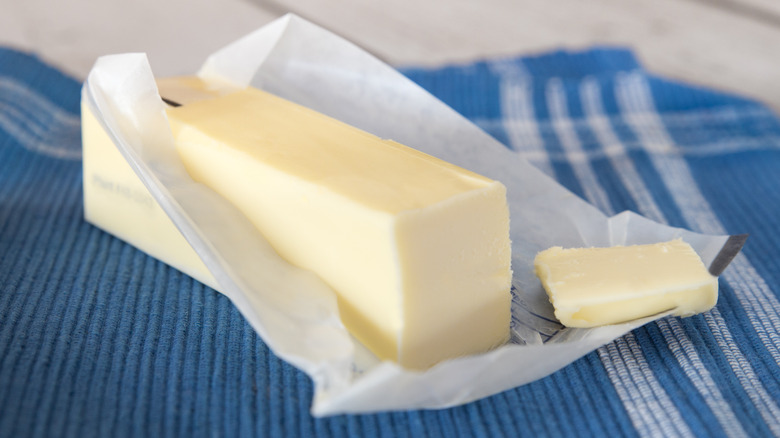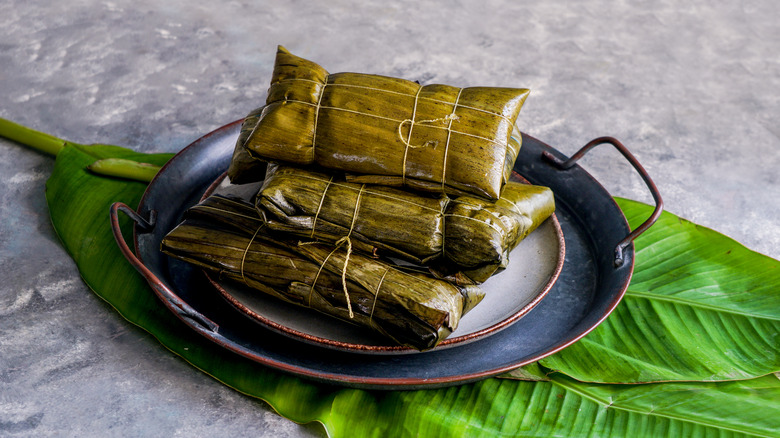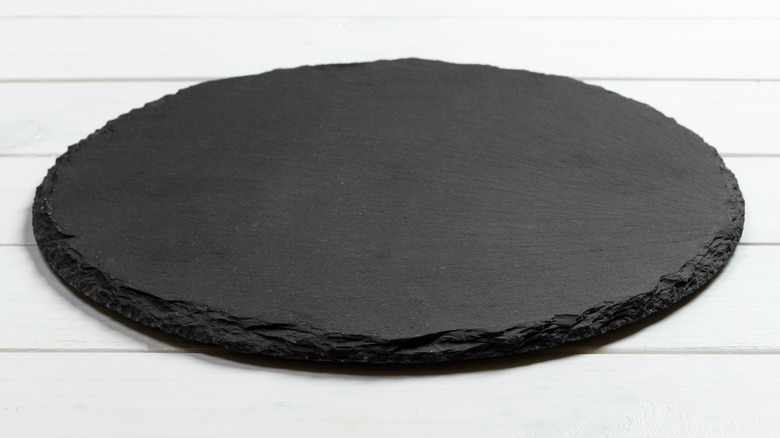9 Best Substitutes For Parchment Paper
We may receive a commission on purchases made from links.
Many cooks and bakers feel that parchment paper is a home essential, but others aren't exactly sold on the stuff and find it problematic in several different ways. For one thing, "The Conscious Kitchen" points out that white parchment paper is bleached with chemicals that can be potentially harmful and that some types of parchment paper are also made with a coating called quilon that contains heavy metals (the kind that could make you sick versus headbang to the rhythm).
Plus, parchment paper can be rather expensive, and it's pretty wasteful. It also can't be recycled thanks to the silicon or quilon coating, which means that it can't be composted, either — after you use your paper, into the landfill it goes. Whether your reasons for avoiding parchment paper are out of concern for the environment, your health, or your budget, you may be glad to know that in many instances, the paper can easily be replaced.
Each of these substitutes has its own advantages such as being cheaper, more heat-resistant, or easier to use than parchment paper. While there's no single item that can be used in all situations, as long as you have a few of these items on hand, you can ditch that pricey, problematic parchment paper for good.
Silpat
If you bake a lot of cookies, the cost of parchment paper can sure add up. One great alternative, however, is the reusable silpat, a baking mat made of silicone. Investing in such a mat might not even run you any more money, either. At the time of writing, Amazon is listing a roll of parchment paper at $14.99 while this set of two silpats costs just $14.39. What's more, the silpats can be re-used time and time again, while parchment paper sheets are pretty much one and done.
There are, however, a few drawbacks to silpats. One being the size, so if you have baking pans in different shapes and sizes you may have to purchase multiple mats. With paper, of course, you can simply cut off the amount you need on a case-by-case basis. Silpats are also too thick to be used as makeshift funnels, and you can't fold the silcone mat around a piece of fish when steaming en papillote.
While you can't always use silpats in place of parchment paper, though, they do have a few significant advantages. The silicone mats are generally oven-safe up to 500 degrees, while parchment paper tops out at 450 degrees. Also, as Buddy Valastro tells the Rachael Ray Show, silpats are usually better for candy making. He explains that melted sugar can stick to parchment paper, with the result being a sticky mess that no-one will want to eat.
Non-stick bakeware
One of the main reasons why home cooks turn to parchment paper for every baking project is so they can be sure that their cakes, cookies, and breads all come out of the pans intact. Sure, parchment paper will help with this, but in many cases it's not strictly necessary. For some baking projects, non-stick cookware alone can do the trick.
Some aluminum bakeware comes with a nonstick coating. Although, as with non-stick frying pans, this coating is rather fragile — meaning that you'll need to avoid metal spatulas. It's also better to wash them by hand as they might be damaged by the dishwasher.
Pyrex bakeware, however, is a bit more robust as its glass surface is naturally non-stick. In fact, you can even use a Pyrex pan as a cutting surface should the need arise. Glass surfaces heat up more slowly than metal ones, however, so Pyrex pans are not recommended for baking bread. What's more, non-stick surfaces don't always live up to their billing, so you still may need to grease your nonstick baking pans just as you'd grease a non-stick frying pan.
Aluminum foil
If you typically line cake pans with parchment paper, you'll know this involves a lot of cutting and shaping to get the perfect fit. With aluminum foil, however, you can just pinch it into place as it's wonderfully malleable. In fact, you can even use your trusty roll of foil for makeshift pan dividers to shape cakes or separate batter colors and flavors. While you may need to use a few layers of foil for this, that's no problem since it tends to be significantly cheaper than parchment paper, and you can probably even pick some up at the dollar store.
If you're using foil in place of parchment paper, though, be advised that it's not nonstick so you may need to grease the surface. A foil-lined pan will also heat up more quickly than a paper-lined one, so if you're using foil to line a cookie sheet, it's advisable to bake your cookies at a temperature five degrees lower than specified. You'll also want to remove the cookies two minutes before the recipe says they'll be done to avoid over-browning the bottoms.
There is one area in which foil has it all over parchment paper: If you are lining your broiler pan for easier cleanup, never, ever use parchment paper! Broilers can get up to 550 degrees, at which temperature parchment paper could catch on fire. Foil, on the other hand, will be perfectly safe for broiling.
Wax paper
Wax paper may resemble parchment paper to some extent, but it's a lot less expensive, so it may be tempting to use it everywhere you'd use the latter. There's one pretty significant problem with this, however: While parchment paper isn't heat-proof, it is heat-resistant enough to withstand most typical baking temperatures. Wax paper, not so much.
This doesn't mean it can't be used for baking, though. Wax paper is fine for lining pans used to bake cakes, bar cookies, or anything where the entire surface of the paper will be covered. This type of indirect heat won't pose a problem, but using wax paper to line a cookie sheet is a no-no since the oven will melt the wax and the paper might burn. If you're cooking in the microwave, though, there's no reason not to use wax paper in place of its pricier cousin. Microwaves don't get nearly hot enough to melt the wax and even if any of it were to melt, the coating is actually pretty safe to ingest.
Other uses for wax paper include rolling it into a funnel for dry ingredients, using as a surface for rolling out dough, or to separate frozen hamburger patties. In fact, most of what parchment paper can do, wax paper can do just as well at a fraction of the price — as long as you keep it away from direct heat.
Cooking spray
One of the primary uses of parchment paper is to help prevent food from sticking to the pan. Well, there's a much simpler, cheaper solution that doesn't involve any cutting, shaping, or other crafting — nor does it create any waste that will wind up in a landfill. What is this miracle substance, you might ask? Why, it's just cooking spray. A few quick squirts and voilà! Your pan is non-stick.
Cooking spray comes in different types to suit any purpose, ranging from butter-flavored to olive oil. It can also help with handy kitchen hacks like keeping hamburger patties from sticking to your hands or prevent water from boiling over. You can make a DIY cooking spray by using cooking oil in a mister or pump bottle. No bottle? Just apply the oil to the pan with a brush or even a paper towel.
One thing that cooking spray shouldn't be used for, though, is to lubricate non-stick pans. The reason for this is because many commercial ones contain lecithin. This substance can build up over time and make your pans even less non-stick, as well as be a real pain to clean.
Grease and flour
Sometimes there really is no substitute for doing things the old fashioned way. With a little bit of elbow grease, plus some actual grease such as butter, shortening, or coconut oil, you can create a nonstick surface in any type of cake pan, no matter how many nooks and crannies it might have. Adding a layer of flour helps ensure that your baked goods come out in one piece. Greasing and flouring works for a cast iron and cookie sheets, as well. Although, with some recipes the grease alone may be enough. If you're looking to do things the quick and easy way (and don't mind spending just a little more), you can use Baker's Joy cooking spray that comes with the flour already in it.
The main disadvantage of greasing and flouring a pan is the fact that yes, you'll need to spend a minute or two scrubbing the pan clean rather than simply crumpling up the spent parchment paper and tossing in the trash. You may, however, sometimes see recipes that call for greasing and flouring (or just greasing) a pan in addition to using parchment paper. In most cases, this is pretty redundant, with the only advantage being that greasing the pan may help the parchment paper stay in place. You'll still need to scrub that baked-on grease out of the pan, so you might as well skip the paper and just use flour instead.
Butter wrappers
If you're committed to a zero-waste kitchen, you probably look for every opportunity to reduce, reuse, and recycle. Well, here's a little tip that will help you reduce your use of parchment paper: reusing butter wrappers. If you do a lot of baking, you probably unwrap a bunch of butter sticks, but did you know that the paper can be put to good use? Butter wrappers, which are designed to be grease-proof and waterproof, typically have a silicon coating that makes them destined to wind up in the landfill. Before you toss them, though, why not use them in place of parchment paper? As it turns out, they may well be made of the stuff.
To be on the safe side, you may not want to use butter wrappers for direct-heat baking since they haven't been tested for heat resistance as has parchment paper. They can, however, be used to line cake pans. Besides being essentially free (with the purchase of butter), these wrappers also have another advantage over parchment paper: The residual butter clinging to the paper can be used to grease a baking pan with the butter wrapper itself making a handy applicator. You can also use butter wrappers to separate baked goods for storing, freezing, or even to cover warm bread. In this instance, the butter inside will melt and add some extra flavor.
Leaves or husks
In addition to being used for baking purposes, parchment paper is often put to use in a cooking technique called "en papilotte." This phrase literally means "in paper" and is typically used for baking fish, but can also be used to cook chicken, vegetables, and fruits. The reason why so many foodies are fans of the en papillote method is because the paper pouches keep all the flavor from evaporating while cooking the contents to tender perfection.
Despite the name, paper isn't strictly necessary for cooking en papilotte. Foil actually works quite well and even though your pouches will be less elegant, they'll have a nostalgic camping vibe to them. If you're concerned about presentation, though, you can go one better here, too, by using leaves. Bamboo, banana, grape, plantain leaves, or even corn husks, all make a fine parchment substitute. Although, with drier leaves and husks you should soak them in water first so they don't get too crispy in the oven.
Nothing at all
There are certain circumstances when the best substitute for parchment paper is nothing at all — just ditch the paper and go with a naked pan. With many types of cookies, there's enough butter in the dough that the cookies are unlikely to stick and a number of recipes will even specify baking on an ungreased cookie sheet. Angel food or other egg white-based cakes, on the other hand, actually need to cling on to the sides of the cake pan in order to rise properly.
You should also skip the parchment paper when you're roasting vegetables. Vegetables cooked on paper just won't brown properly, so you're better off cooking them on a plain pan or even directly roast on the floor of the oven. Pass on the parchment when using a pizza stone, as well. These work best at very high temperatures (500 F), whereas parchment paper is not designed to withstand such heat. It should also go without saying (though we'll say it anyway, for safety's sake): Never deep-fry foods in parchment paper! Not only will this cause the paper to overheat in a dangerous way, but the whole point of frying is to have the food in direct contact with the hot oil. Crunchy deep-fried paper on a stick is something that wouldn't even fly at the wackiest state fair concessions would stand on the midway.
